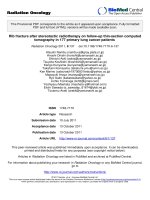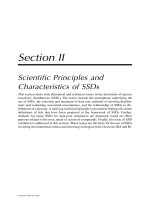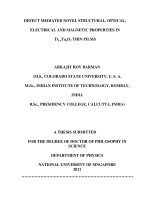Igneous rock in thin section
Bạn đang xem bản rút gọn của tài liệu. Xem và tải ngay bản đầy đủ của tài liệu tại đây (10 MB, 81 trang )
IGNEOUS ROCK IN
THIN SECTION
Contents Image field widths
Quartz
Plagioclase
Potassium feldspars
Myrmeckite
Micas
Amphiboles
Pyroxenes
Other rock-forming primary minerals
Accessory minerals
Secondary (subsolidus) minerals
20x = 6 mm
40x = 3 mm
100x = 1 mm
200x = 0.5 mm
400x = 0.25 mm
1000x = 0.1 mm
Quartz
Quartz crystals in alkali granite. Quartz is typically the clearest mineral in rocks,
because it is not very succeptible to alteration to fine-grained minerals, and it has no
cleavages.
Plane polarized light, 20x
NEIGC86-B2-7
Quartz crystals in alkali granite. Birefringence in the low first order.
Cross polarized light, 20x
NEIGC86-B2-7
Strained quartz crystal in a metaluminous granite. Strain has caused the quartz crystal
to deform into domains with slightly different extinction angles. Typical for quartz, not fle
feldspars.
Cross polarized light, 20x
DIG-D
Fluid inclusions in quartz in alkali granite. The inclusion in the center has an irregular
outer boundary, inside of which is a layer of liquid water, a layer of liquid CO2, and a
central bubble of vapor (mostly CO2). At the time of trapping of this secondary inclusion,
the fluid was a homogeneous H2O-CO2 fluid.
Plane polarized light, 1000x
NEIGC86-B2-7
Fluid inclusions in quartz in alkali granite. Several inclusions containing (probably)
water and a vapor bubble.
Plane polarized light, 1000x
NEIGC86-B2-7
Plagioclase
Plagioclase, unzoned, in a hornblende diorite. Ateration to fine-grained products
typically follows fractures, twin planes, or cleavages. In the solid solution series, the
plagioclase refractive index varies from slightly lower than quartz to somewhat above it.
Plane polarized light, 40x
NEIGC84-A5-5C
Plagioclase, unzoned, in a hornblende diorite. Note the strong, parallel sets of albite
twins, and the less visible set of pericline twins inclined almost at right angles to the
albite twins.
Plane polarized light, 40x
NEIGC84-A5-5C
Plagioclase, zoned, in a dacite porphyry. This plagioclase appears quite homogeneous
in plane light, without concentric zones of inclusions that are commonly seen in other
grains.
Plane polarized light, 100x
Rhyolite-2
Plagioclase, zoned, in a dacite porphyry. This plagioclase has fine oscillatory zoning, in
which the composition varies between more and less anorthite-rich compositions.
Internal unconformities followed by euhedral overgrowths are also visible.
Cross polarized light, 100x
Rhyolite-2
Plagioclase, zoned, in a dacite porphyry. Notice the concentric layers (zones) of
inclusions in this crystal. These probably formed during faster crystal growth than the
clear zones.
Plane polarized light, 40x
Rhyolite-2
Plagioclase, zoned, in a dacite porphyry. Notice that the concentric inclusion zones
also have different birefringence, indicating these zones have different anorthite content.
The interior of this crystal has patchy zoning rather than concentric, indicating skeletal
early growth. Albite, carlsbad, and pericline twins cut across the composition zones.
Cross polarized light, 40x
Rhyolite-2
Potassium feldspars
Orthoclase in a dacite hypobyssal intrusive. In plane-polarized light K-feldspars may be
difficult to tell from plagioclase, though they have refractive indexes lightly lower than
even albite. Hint: to highlight K-feldspar, switch of a medium-low magnification objective
(4-10X, depending on the optics), mostly close the substage iris, and raise the stage
slightly (yes, raise). Though the image will be somewhat out of focus, the low index K-
feldspar grains will be surrounded by bright Becke lines just inside the grain boundaries.
This is especially handy in tonalites, in which K-feldspar may be hard to find by other
methods.
Plane polarized light, 40x
Py-28
Orthoclase in a dacite hypobyssal intrusive. Notice the two carlsbad twin domains,
separated by the carlsbad composition surface. The lack of polysynthetic twinning and
lower refractive index than
Cross polarized light, 40x
Py-28
Microcline from a peraluminous granite. Characteristally featureless, like orthoclase, but
the inverse Becke line highlighting technique (see orthoclase, above) works just as well.
Plane polarized light, 20x
Kinsman
Microcline from a peraluminous granite. Note the "grid" or "tartan plaid" twinning pattern
that results from crossing albite and pericline twin domains. These are formed during the
change from monoclinic high temperature orthoclase to triclinic low temperature
microcline, associated with progressive ordering of aluminum and silicon during cooling.
Albite and pericline twins are impossible in monoclinic orthoclase and sanidine, and
develop like this only during inversion to triclinic microcline. The triclinic twin domains
can nucleate with the triclinic angles leaning one way or another, but once they start that
is how the twin grows. Because many twin domains nucleate, there are large numbers of
thin, spindly and discontinuous domains in the final microcline product. Because the grid
twinning is an inversion texture, it shows that the original feldspar was once monoclinic.
Microcline crystals that grow below the inversion temperature do not have grid twinning
like this.
Cross polarized light, 20x
Kinsman
Microcline from a peraluminous granite. Closeup of the plaid twinning. Notice how the
twin domains are spindly and somewhat wispy. This is in contrast to the straight and
generally continuous twin domains in plagioclase. Note the different spacing of the twin
domains. This shows that different volumes of the crystal nucleated different numbers of
twin domains during inversion.
Cross polarized light, 100x
Kinsman
Perthite from a metaluminous biotite granite. Note the faint, irregular stripes that run
from the upper right to lower left. In this case, the exsolved albite is less altered (clearer)
than the adjacent microcline, which is grayish here because of lots of minute alteration
minerals.
Plane polarized light, 20x
4.7.84H
Perthite from a metaluminous biotite granite. Note the lighter irregular stripes and
patches of bright yellowish-white albite between dimmer gray stripes and patches of
microcline. The color difference is mostly caused by the different optical orientations of
the two different minerals. The microcline and albite both exsolved (unmixed) from an
originally homogeneous high temperature of intermediate composition. In this photo the
thin section was rotated to obscure the twinning.
Cross polarized light, 20x
4.7.84H
Perthite from a metaluminous biotite granite. The somewhat less altered and narrower
albite exsolution lamellae are in sharp contact with a much larger microcline domains.
You can see a lamella closeup here, and then see a Becke line test from focused to
a lowered stage position at the lamella-microcline contact. The Becke line goes into the
higher index phase, albite.
Plane polarized light, 100x
4.7.84H
Perthite from a metaluminous biotite granite. Same as the image above in cross
polarized light.
Cross polarized light, 100x
4.7.84H
Perthite from a metaluminous biotite granite. Closeup showing the characteristic grid
twinning in the microcline host (upper center and upper left) and albite twinning in the
lamellae (lower center to center right).
Cross polarized light, 200x
4.7.84H
Myrmeckite
Myrmekite patch that appears to be replacing microcline, though its appearance is
obscure in plane-polarized light.
Plane polarized light, 40x
Kinsman
Myrmekite patch that appears to be replacing microcline. Twins in the myrmekite clearly
show that the quartz "worms" are in a plagioclase matrix. Myrmekite is a subsolidus
reaction texture that generally results from fluid flow. Here, K-feldpar was removed and
quartz and plagioclase deposited in its place.
Cross polarized light, 40x
Kinsman
Micas
Muscovite, peraluminous granite. Igneous muscovite is generally colorless with good
cleavage. Pale brown radiation halos can sometimes be visible around radioactive
inclusions (but not really visible here).
Plane polarized light, 40x
NEIGC84-A5-6









